A simple question, was the British Infantry more effective with the 51 mm lightweight infantry mortar than it is now, without it?
In an age of swarming drones and artificial intelligence, it is easy to lose sight of the basics. In this case, the ability of an infantry platoon commander to produce smoke, illumination, and high explosive effects at range and out of the line of sight to support manoeuvre and closing with the enemy.
The L9A1 51 mm mortar was a simple design, able to be operated by a single person, although usually operated in pairs. The mortar weighed 6.3 kg and, depending on its ammunition nature, was effective at up to 750m. Smoke, HE and illumination rounds were available, weighing between 0.8 kg and 0.9 kg.
The rate of fire could be up to 8 per minute.
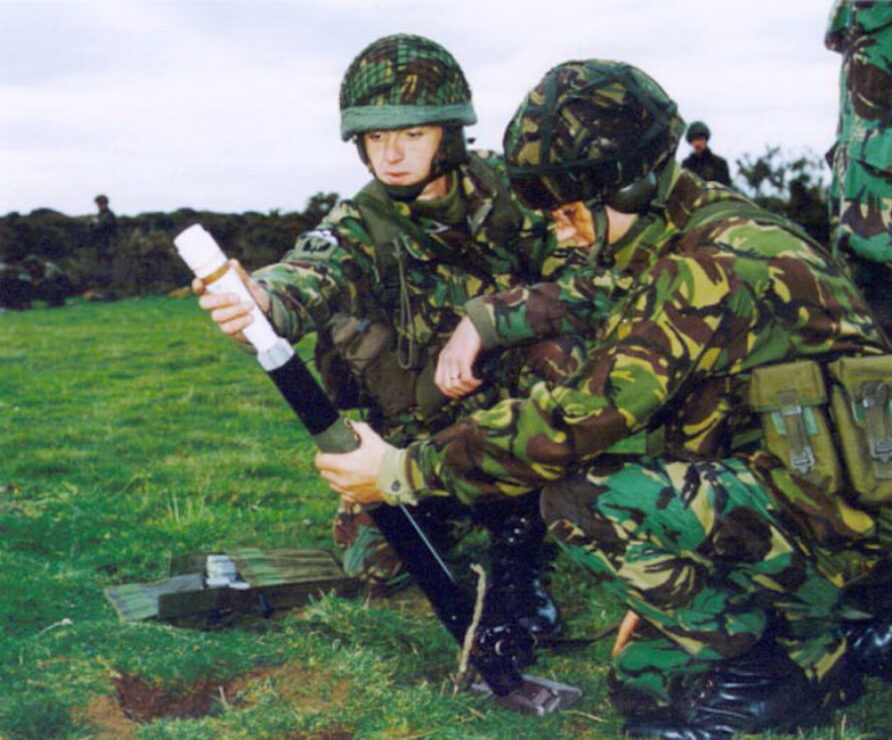
The greatest strength of the 51 mm mortar was its simplicity and low weight, less than 24 kg for the complete weapon and 18 bombs. The training burden was low and was cheap to use; thus, it was used often in training, and proficiency levels reflect this.
Although the HE round was relatively small, aggregating them at the Company level was sometimes used to maximise effects. Because it was organic to the Platoon HQ, it would be available immediately, and without complication.
You can find the 1966 training manual for the 2″ light mortar online (click HERE), the mortar section comes in at a minuscule 35 pages.
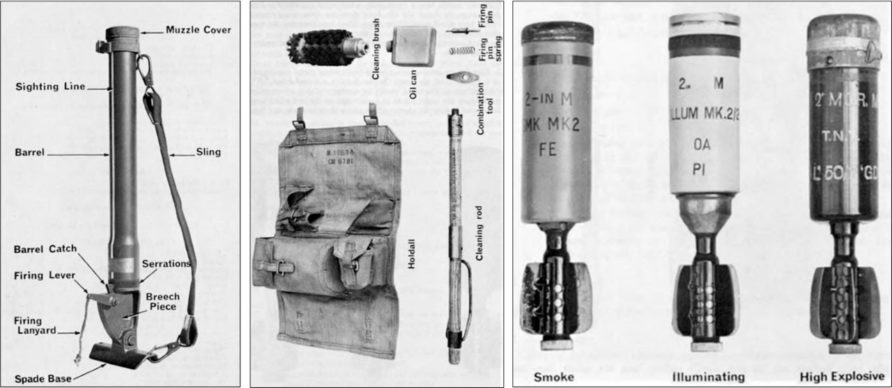
Operations in the Middle East depleted ammunition stocks to the point of a decision. The British Army could have contracted to remanufacture of out-of-production natures, not in service with anyone else, or, look to the market for alternatives.
The alternative option was taken, and the Hirtenberger 60 mm Platoon/Company mortar was selected after a short evaluation.
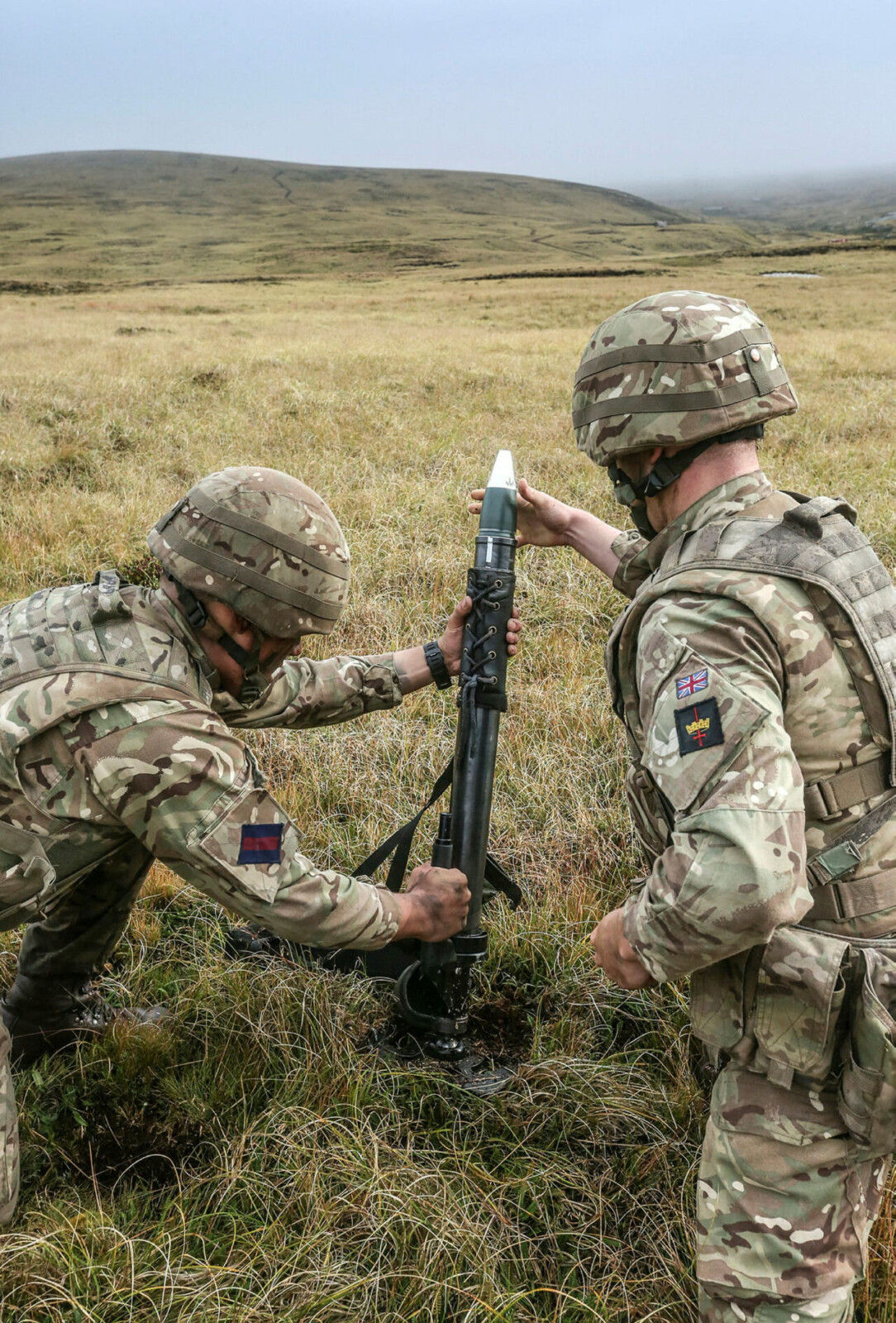
The Hirtenberger system was obtained in two variants (although there is some commonality between the two), the M6-410 with baseplate and bipod,
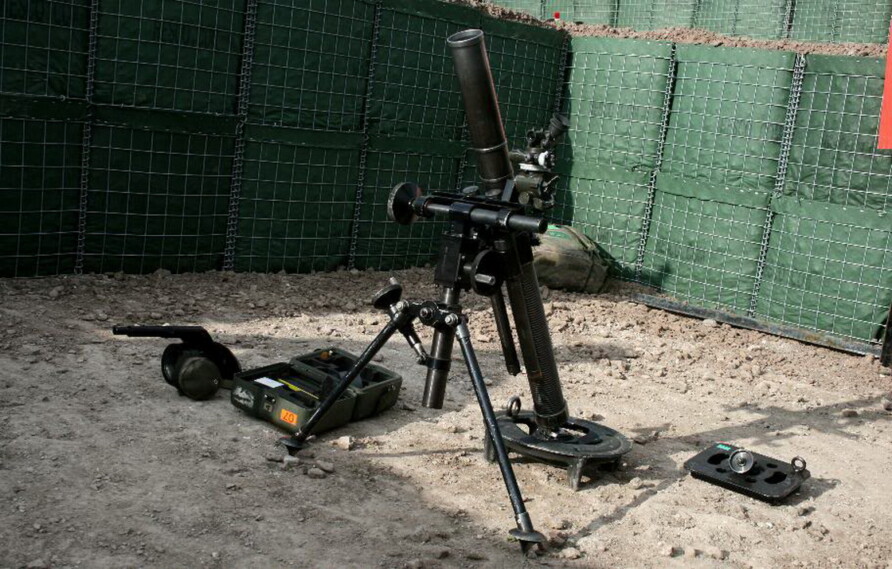
and the handheld version, often termed ‘commando mortar’,
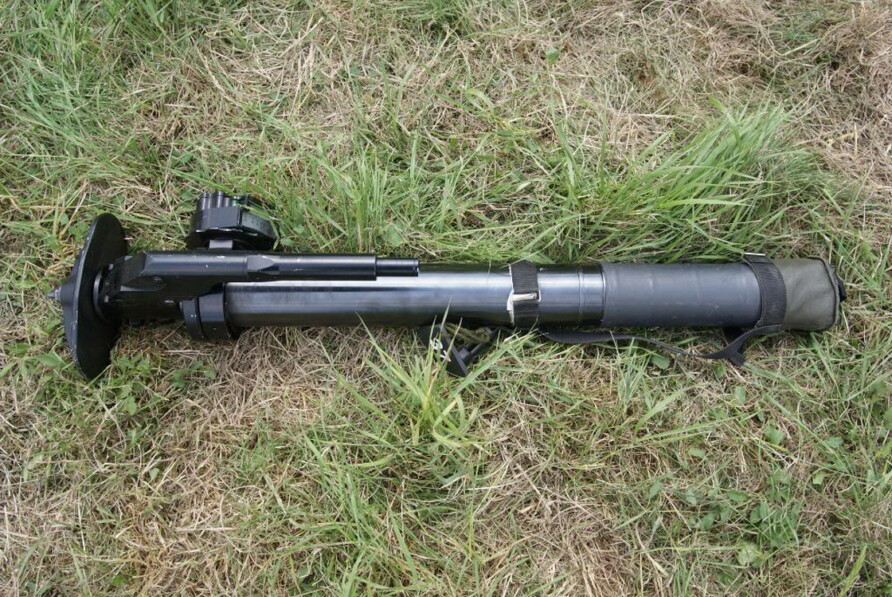
The range (1,300m) and more effective ammunition were considered a great advantage over the 51 mm, especially where platoon engagements might be at longer ranges.
Longer engagement ranges also resulted in the introduction of the L129A1 Sharpshooter rifle.
The problem with the Hirtenberger system was its weight, too heavy.
It provided marginal gains over 51 mm, but was nearly as heavy as the 81 mm. There is no way it was ever going to replace the fiercely effective 81 mm mortar, and maybe an element of culture also played a part.
Eventually, it was withdrawn.
British Army infantry was left only with 40 mm Underslung Grenade Launchers (UGL) for organic indirect fire. A contract was also awarded to Istec Services for several UGL fire control systems. These were called the Rapid Acquisition Aiming Module, developed by Safran Vectronix and Wilcox Industries., shown below on an SA80-A2
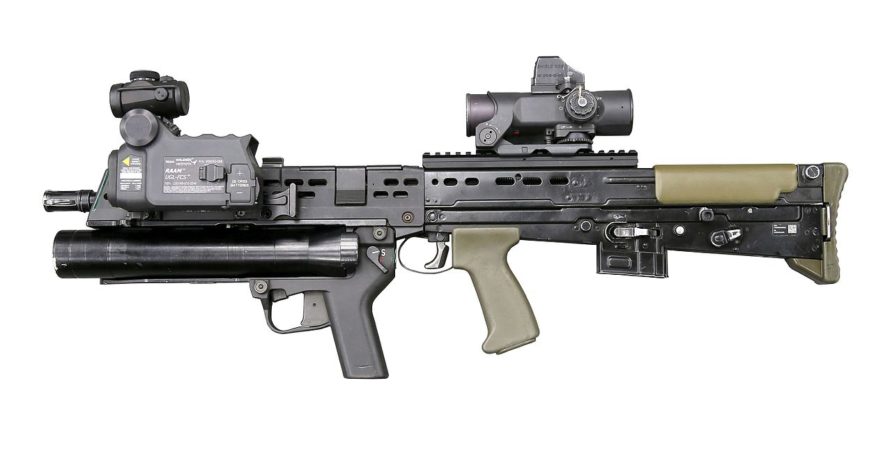
These remain in service, but it is not known how widely they are used, recent media output from the MoD would indicate not very often. No medium velocity 40 mm grenades have been introduced for extending the range beyond 300m, and smoke and illumination natures provide only limited range and burn time.
Before reading on, would you mind if I brought this to your attention?
Think Defence is a hobby, a serious hobby, but a hobby nonetheless.
I want to avoid charging for content, but hosting fees, software subscriptions and other services add up, so to help me keep the show on the road, I ask that you support the site in any way you can. It is hugely appreciated.
Advertising
You might see Google adverts depending on where you are on the site, please click one if it interests you. I know they can be annoying, but they are the one thing that returns the most.
Make a Donation
Donations can be made at a third-party site called Ko_fi.

Think Defence Merch
Everything from a Brimstone sticker to a Bailey Bridge duvet cover, pop over to the Think Defence Merchandise Store at Red Bubble.
Some might be marked as ‘mature content’ because it is a firearm!
Affiliate Links
Amazon and the occasional product link might appear in the content, you know the drill, I get a small cut if you go on to make a purchase
Framing a discussion on Lightweight Infantry Mortars
Range; There is a constant debate about the ‘typical engagement range’ for dismounted infantry, and this typically leads to a desire to burden the infantry section and platoon with weapons that cover a significant range. Infantry cannot afford to carry more weight, they are already significantly overburdened (click here for a long read on just that subject) as it is. The infantry platoon has a good spread out to 2 km if equipment like GPMG in the sustained fire role or Javelin is included, GPMG out to 800m, and NLAW and Sharpshooter Rifle out to 500m, with 40 mm UGL to 300m.
Effects: 40 mm UGL is a Section Weapon, used in the direct fire mode where the target is seen by the firer. The platoon doesn’t have the means of providing indirect or high-angle fire with its resources. Smoke and illumination (visible or IR) are limited to what can be provided by 40 mm and disposable rocket flare-type devices with limited burn time and coverage. Discussions on these matters tend to ignore smoke and illumination, but they are vital. With the proliferation of thermal imaging equipment, multi-spectrum obscuration will be increasingly important, perhaps more important than HE.
Employment; Infantry company and platoon organisation changes in response to tasks and environment, its inherent flexibility is a great strength. As we move into more disaggregated operations, infantry platoon and company structures might change. The impact on equipment decisions of projects like UGVs, autonomous carrier vehicles, and even the increasing preponderance of UAVs and loitering munitions has yet to be fully understood. Light Role infantry might also have a wholly unique approach to weight and fire support in the attack, compared to mechanised infantry, another set of considerations.
One option might be to push 81 mm down to the infantry Company level which would be worthy of discussion, especially on matters of culture, training burden, standards, and safety. Another might be to enhance platoon firepower with something like the latest version of the evergreen Carl Gustav. The British Army has been considering such an approach for several years. Not only would it improve firepower at the platoon level, but it can also be used to deliver smoke and illumination. This will be the subject of another post but bear that option in mind.
Assuming that ‘something like the 51 mm mortar’ is desirable, what qualities would be needed?
- A range of natures including smoke and illumination
- 800m maximum effective range
- Low training burden delivered by simplicity
- Low weight
- Flexibility
- Sustainability across the platoon
The last bullet point is closely related to the weight, being able to distribute mortar bombs across the platoon.
A Few Options
I have discounted things like armed UAS, loitering munitions and multi-shot grenade launchers as I don’t believe they meet the bullet point requirements, especially weight and simplicity.
Lightweight 60 mm mortar systems are available from many of our allies.
Denel in South Africa produce the M4-60,
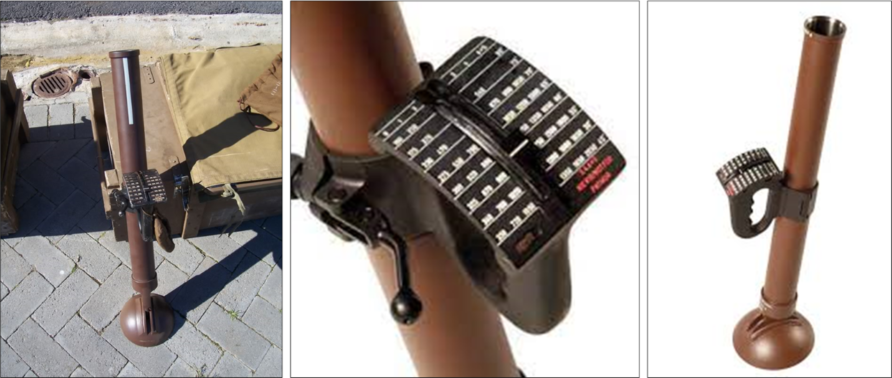
As simple as they come, the M4-60 weighs 6.9 kg. Very similar to the M4-60, Serbia produces the M06C 60 mm Commando Mortar with very similar specifications, although slightly heavier at 7.6 kg and with a claimed longer range of 1,600m
US Forces use the M224A1, an improved version of the seventies-era M224. It is a 60 mm mortar system used with a baseplate and bipod or in the handheld configuration.
An excellent description of the 2M224A1 can be found at this link, but in the handheld role, it weighs 7.5 kg (barrel and M8 baseplate). It is also compatible with 60 mm mortar rounds, weighing 1.3 kg and 1.8 kg. We can also be certain these will be continually developed, an attractive aspect of any US weapon system.
The Rheinmetall RSG60 is relatively new and can be used in two modes, like many conventional 60 mm mortars
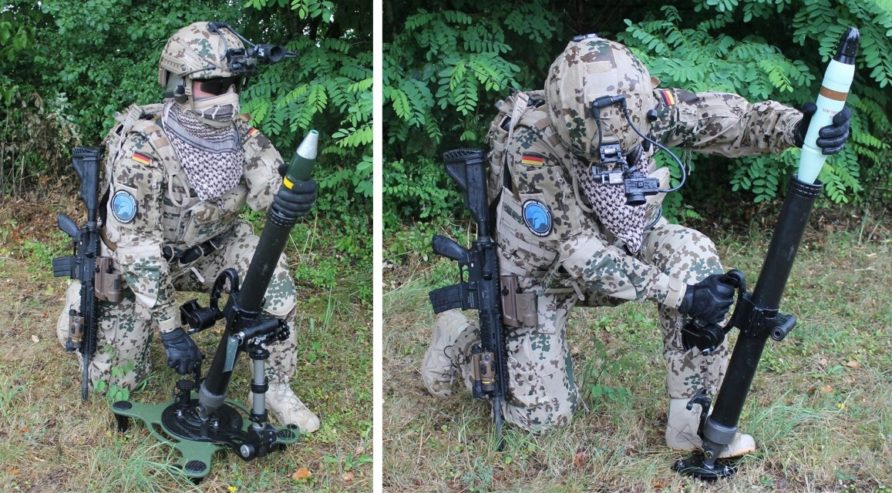
The usual range of natures is available, and it weighs 6.8 kg in the ‘commando’ configuration.
The Czech Military Technical Institute VTU designed a 60 mm commando mortar system called the LRM Vz99 ANTOS. The same design is marketed and sold under many brand names. It has a liquid-filled sighting window and weighs just under 5.3 kg. The maximum range is said to be 1,30om.
An interesting feature of the ANTOS system is the range of natures, including thermobaric explosives, further details here
From Poland, the Tarnów LMP-2017 looks superficially similar to the ANTOS, although it is heavier at 7.5 kg, and using a steel barrel has a claimed longer life.
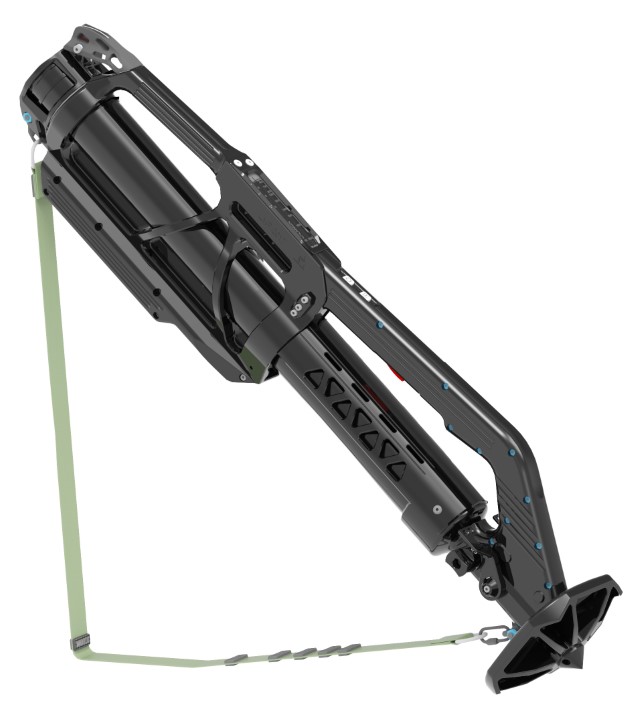
All of the above use 60 mm mortar ammunition, but the French/German Fly-K takes a different approach. Evolved from an old Belgian design, it uses a captive piston to reduce the firing signature, 52dB at 100m. More of a rifle grenade projector than a mortar, the individual rounds are 51 mm in diameter and available in a range of natures with a maximum range of 800m.
The system and rounds are very light, 4.8 kg and 0.8 kg respectively.
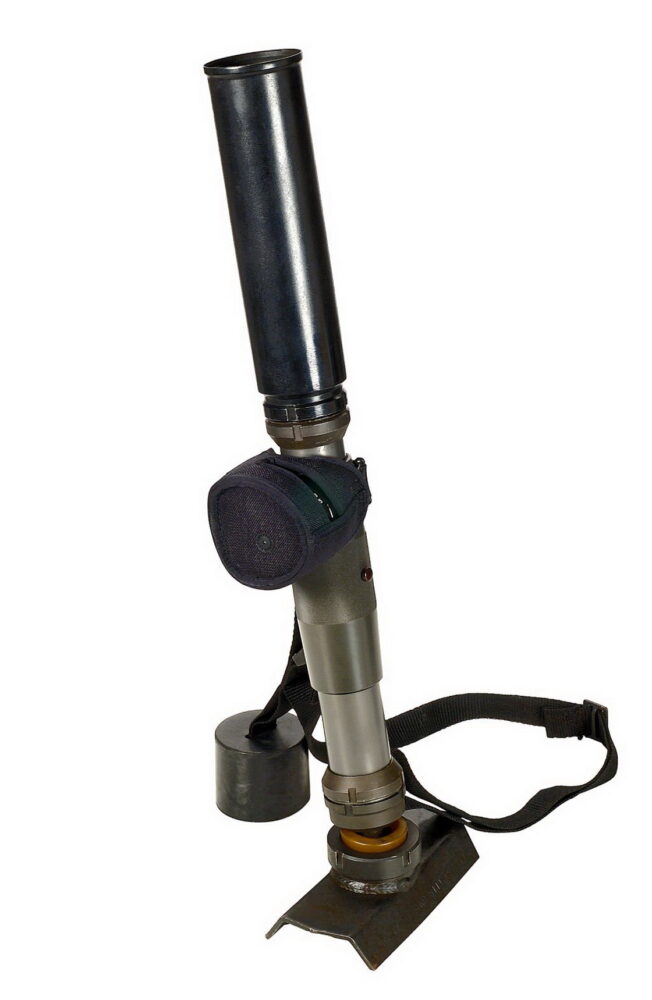
The device in the image below is a multi-shot launcher that can be manually initiated or in response to external sensor input. French forces used them in Afghanistan with a rapidly introduced digital inclinometer to improve firing accuracy.
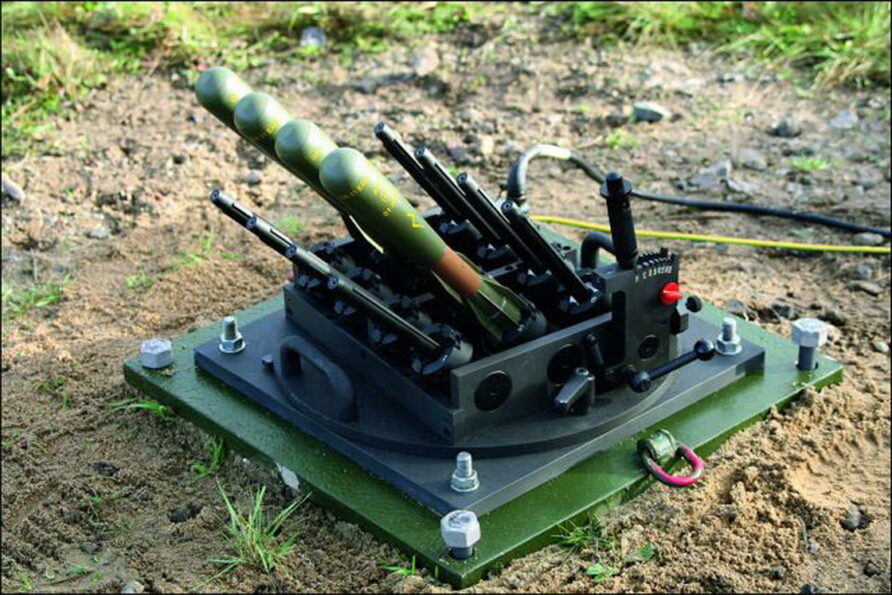
video
I am not suggesting we rush out and buy it, but the Chinese QLT89 50 mm mortar looks interesting, somewhat similar to the Fly-K. It weighs just over 4 kg and has a maximum range of 800m.
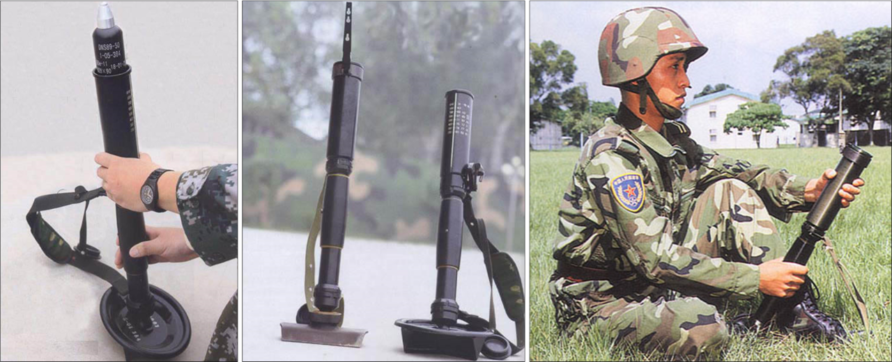
As with the Fly-K, arguably more of a grenade projector than a mortar, with each round weighing approximately 0.7 kg.
Another to look at but stand fast with the credit card is the Russian 82 mm 2B25 ‘silent mortar’ from Burevestnik
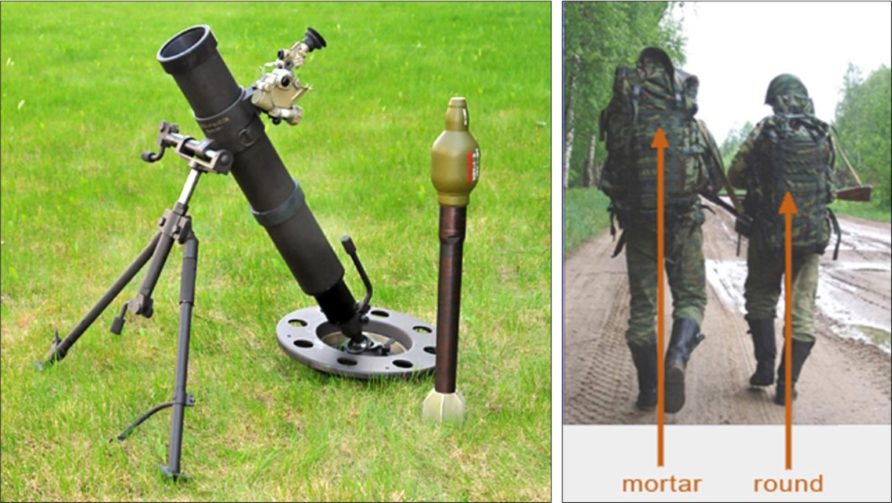
At 13 kg, it is at the heavy end but with a maximum range of 1.2 km and a minimal firing signature, intriguing nonetheless.
Thoughts
This is far from anywhere near my usual fare, but I do think there exists a gap. And instead of coming up with ever more complex ever more expensive solutions, that gap should be filled with something simple, light, cheap, versatile, and did I mention cheap and simple?
The Fly-K type grenade projectors are certainly appealing, the low signature and low weight make them immediately attractive, as does the hedgehog thing. Do they have the range of natures to make them versatile enough for the longer term, perhaps not.
This brings us back to 60 mm mortars, are any of those described above materially different to the Hirtenberger we have recently withdrawn, I certainly don’t know. The ANTOS does look like a suitable option, light and with a good range of natures, but is it durable enough?
As always with these things, picking a winner is not something to be done in a blog post, but hopefully, this has demonstrated there are alternatives out there if we choose to fill the gap. And this is before we get into the subject of fire control and target acquisition, yet another subject for a future post.
No doubt we have tried them all, compared rocket flares to 40 mm grenades and all manner of mortars to compare manufacturers’ claims to reality, and tested durability and effects, just waiting for the magic money tree to be forthcoming.
Read more (Amazon Affiliate Link)

Discover more from Think Defence
Subscribe to get the latest posts sent to your email.


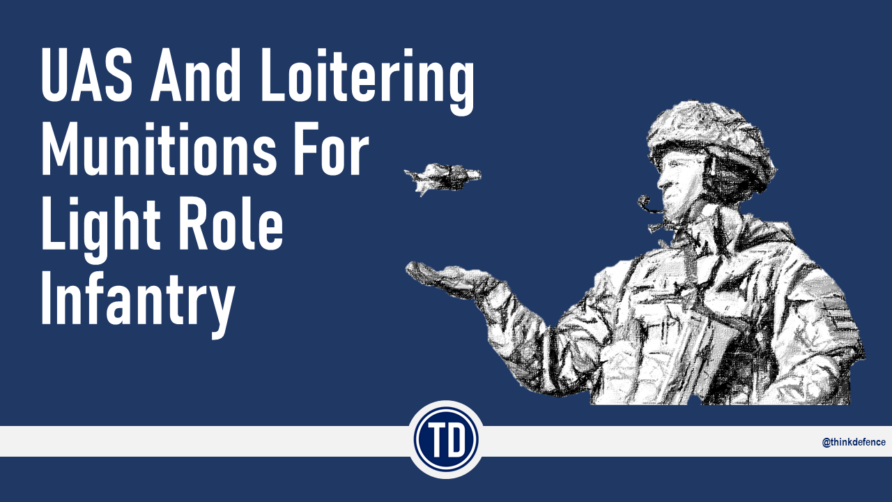
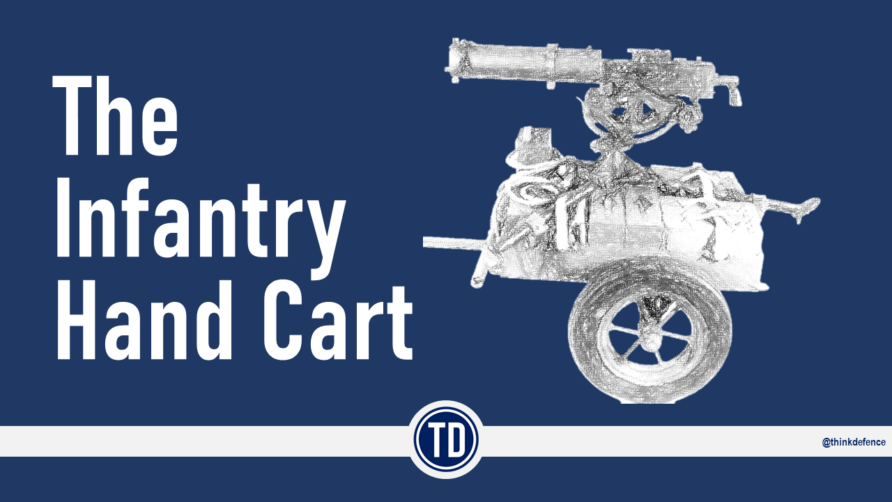
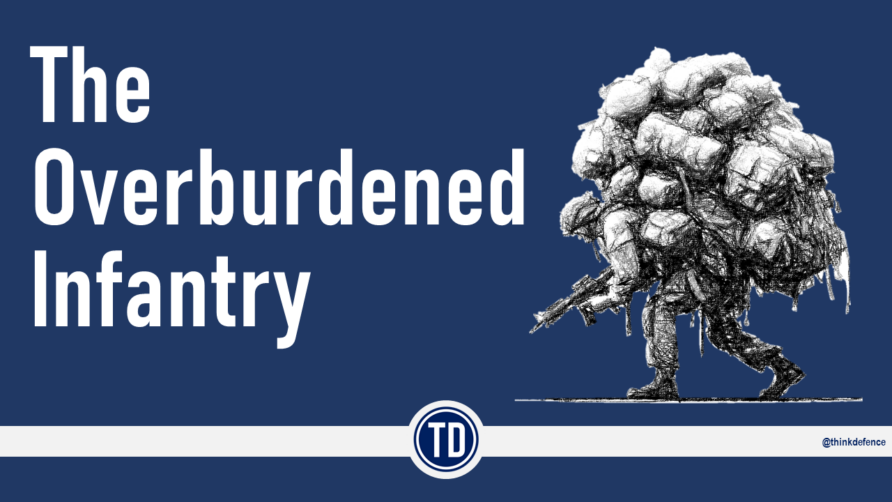
PIAT? 🤣🤣
There are two more light captive piston mortars.
“Delta” from Georgia (Delta State Military Scientific and Technical Centre): 60 mm, 300 mm length, less than 5 kg, 800…1,200 g bomb weight, MV 90…130 m/s, range max. 600 m, less than 60…65 dB
“Norinco Jerboa” from West Taiwan: 50 mm, 600 mm length, 3.8 kg, bomb 700 g, 200…800 m range
Data as per “Jane’s Infantry Weapons 2004/2005”.
Personally, I suppose only IR Illum and multispectral SMK are sensible munitions for commando mortars, and I have developed doubts that IR Illum is advisable or necessary at all because there’s an alternative option. So that would leave only smoke.
Commando mortars could project smoke to the front of known or suspected enemy infantry positions or to provide concealment on a patch of open terrain that needs to be crossed and is too wide for hand-thrown smoke munitions.
Great article
It’s interesting that again our allies & potential opponents again have options that our troops don’t!
I believe that there is a gap also with Black Hornet & nano bug type drones this would give an instant IDF option even if NLOS allowing multiple rounds on target. Away from HE rapid smoke, EO, IR rounds all useful options.
It is looking like H&S is going to get in the way of the Carl Gustav being adopted in UK service. Other options are unlikely to be able to employ non- explosive rounds.
The USMC also have the multi-tube grenade launcher, CG, 60mm, 81mm, 120mm mortars why does the UK always seem to lag behind in firepower?
Another more technical option could be to adapt a THEMIS UGV to fire the 81mm & potentially carry rounds taking the weight burden from the troops. The 120mm could replace the 81mm mounted on a Jackal or similar. It may however also be useful to be able to revert to manual systems which, however would leave troops with the heavier 81mm.
Overall simply introducing something like the ANTOS would give an easy lightweight solution.
Out of interest I wonder how long it will be until fire support groups adopt UGVs yes retain & train the shanks pony method but seems sensible to make use of load carrying capacity?
About the niche:
Neither 40 mm LV nor 40 mm MV offer the same range, as a commando mortar albeit 40 mm MV offers enough range in most instances and much less minimum range.
The question is the munition. What should such a mortar do at all? I usually say illumination and smoke (enhancing and degrading visibility). HE is a rather questionable choice because it requires much training to get the aiming at least approx. right and even then it’s only reasonable to expect multiple shots to land one close enough for effect. (the effective radius is smaller than for a comparable tech defensive hand grenade and depends much on the direction and impact angle).
How many bombs would be carried along the ~5 kg commando mortar and in addition to a proper assault rifle with proper sight and 180+ 5.56 mm cartridges + magazines?
10 mortar bombs already guarantees that the infantryman is overburdened.
40 mm MV stand-alone single shot grenade launcher could be had at little over 2 kg. The individual shots weigh less, but also do less than 51 mm mortar bombs. Aiming is easier, particularly against vertical targets (windows, doors). Minimum range is shorter than throwing range. Maximum effective range is approximating assault rifle combat distances.
I just don’t think that 40 mm is a worthwhile calibre for smoke. 40 mm LV has 50…75 g of smoke agent, whereas mortar bombs of about 51 mm have 180…500 g.
I think there’s by now a better alternative for illumination, so 40 mm would have to win with HE and here again I am not convinced. You can shoot enemies with 5.56 mm that you see and can identify. Shooting at unseen enemies with 40 mm seems like an ill-disciplined approach that only leads to very temporary stress relief at the expense that your troops are overburdened.
Shooting into windows with a nose fuse 40 mm HE (NOT HEDP, as this has marginal frag to rear 180°!) may count as an exception. Question remains, why not wait till target is exposed? A suppressed target is not much of a problem.
You need to cut away some firepower/protection capability if you want capability by ability to move well, which so far is only possible if you avoid overburdening the infantry.
correcting myself:
The QLT89 is apparently the NORINCO mortar I wrote about, so TD only missed the Georgian Delta 60 mm captive piston spigot mortar.
https://ndiastorage.blob.core.usgovcloudapi.net/ndia/2010/armament/WednesdayLandmarkBJuanjuanYang.pdf
I like the idea of putting the 81mm at company level, could we then go French style and re role the Heavy Weapons platoon/troop with 120mm mortars – vast improvement in unit firepower?
Regrettably the Australian Army has converted all reserves to training with 81mm mortars which will not help if we get into conflict!
81 mm and missiles (NLAW is often a called a ‘missile’) best left at the company level… so enter the M72 -like weapons that can easily be incorporated i training and then distributed in quantities as per needs arising (one man can carry several; and they now come also in AB and anti-structure varieties, without a weight penalty vs. the std issue).
More of a direct fire weapon though, and inferior in range to UGLs
– the two together should cover most occasions?
… now coming back to the ones listed by OS, where there though will remain a gap to be covered
RPG would do the job :-)
The UK's use of a 51mm mortar was simply the army clinging to the old 2" history of the past. It makes no sense to have a 51mm weapon when the bulk of the UK's allies use 60mm.
David Ross's comment is essentially what the British Army does. The 81mm mortar platoon is a battalion asset. This allows the CO to deploy them as he needs them, task dependant. However, a three mortar section in support of a company is regularly used. It is a fantastic weapon, which, with well trained troops provides rapid and effective close support for the battalion. They are 75% of a battalions fire power. Their only real drawback is their use on soft ground. The problem was well and truly identified during the Falklands conflict. The army's response was the Rachen bag. The system was developed as an idea to be improved on, as usual the MOD failed to look for anything better. It is nearly as bad as building 'rafts' of sand bags or putting the baseplates in sand filled 45 gallon oil drums. Both Brit Mil pamphlet recommended techniques. Both work, but are highly work intensive and offer nothing in the shoot and scoot battle, an essential part of battle field survivability.
The light infantry, (including paras and commandos) need a specific lightly armoured mortar carrier and ammunition carrying vehicle. Bring back the Bren Gun carrier!? Well a modern version of it. It was the most versatile of tracked vehicles used during the 2nd World War and will be again.
As to 120mm mortars: These need to be integrated at brigade level. A twelve weapon platoon/company with its own carrier vehicle. Ground role for the light infantry units, vehicle mounted for the armoured infantry. If the procurement is done correctly all of the systems can use the same sights, computers and digital links to the MFCs and Fire Control Centres. Saving training time effort and money and potentially making them interchangeable between platoons and systems. Twelve barrels will allow the brigade commander great flexibility in his deployment and use of them in support of his battalions.
There is a line of thought that says that light mortars can be replaced by 40mm AGM. As effective a weapon as they are, they do not have the punch or ammunition type flexibility to make them a viable replacement. Particularly when it comes to the provision of illumination and smoke cover.
The mortar in all its forms is here to stay. The MOD needs to get past its desire to buy shiny Gucci kit and understand that battles are fought and won in the mud and dirt of the field. The only way they are won is by well trained men using weapons that they know and trust. Not ones bought on a panic contract because there is an operational equipment shortage as the Hirtenberger system was.
We have patented a .50” cal. anti-material pneumatic rifle which could be up rated beyond 40mm. Its advantages are accuracy of range and hence enhanced chance of first round hit. Also, without the propulsion charge, the weight of the projectile becomes much lighter and can carry a much enhanced explosive load. Please send an e-mail address, and we shall send details.
We are looking to license this, especially in the higher calibres.